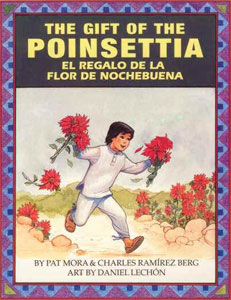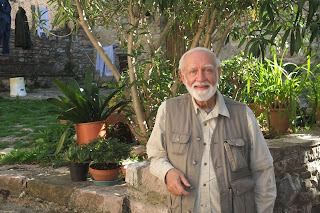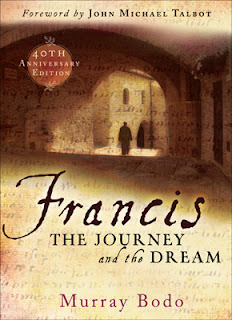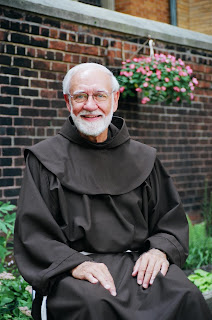Jeanette Larson posted about “Celebrating Las Posadas” on the ALSC blog and mentioned Pat’s book Gift of the Poinsettia/ El regalo de la flor de nochebuena. Las Posadas re-enacts Joseph and Mary’s journey to Bethlehem and is celebrated throughout Latin America.
Bookjoy at NCTE
I had the pleasure of preparing for two programs. I say “pleasure” because I love presenting as much as I love writing and because such preparations are opportunities to think, and we all know that creating thinking time can be a challenge. I joined poet Joyce Sidman and two faculty members in offering a master class on “Poetic Voices: Writing, Reading and Responding to Poetry.” Frankly, I seldom have the opportunity to hear another writer, and I so enjoyed hearing Joyce read her fine poems and explain how a poem evolves for her. For the first time, I prepared a PowerPoint of my books of poems and rhymes in the order the books were published. In addition to reading some poems especially from Dizzy in Your Eyes: Poems About Love, I asked the audience to think about what voices (and languages) are included in our poetry. I was asking: who belongs in poems and what do poets look like?
I was introduced at the Conference on English (CEL) breakfast by my friend Dr. R. Joseph Rodríguez from the University of Texas. Joseph, a dear friend, often knows my work better than I do. I struggle almost daily to find time to continue my own writing and to promote Día and family literacy. I seldom consciously sit and think about leadership, also a topic of great interest to me. My title, “Creatively Practicing Resilience: The Zing of Bookjoy” allowed me to address some of my key themes but also to explore potential: our personal potential as leaders, the potential of the literature and literacy field, and the potential of our collaborators.
May we all be bolder and more creative leaders in 2012! Wishing you health, happiness and bookjoy.
In 1986, I was fortunate to receive a Kellogg National Leadership Fellowship, a three-year experience that greatly enriched my life. In 2001, the W. K. Kellogg Foundation published a book entitled, Leading from the Heart: The Passion to Make a Difference. My essay and its introduction are from that book. It’s interesting how many of the ideas in this piece are part of ZING! published in 2010.
The Gift of Poetry
Gift Tag is the third poetry e-book compiled and edited by Sylvia Vardell and Janet Wong. These poetry anthologies feature poems by many well-known contemporary poets and Pat has poems included in Poetry Tag Time and Gift Tag.
Gifts and giving is the theme chosen for Gift Tag. Photos (taken by Sylvia Vardell) served as prompts for each poem and each poet also wrote a “connection” piece explaining how the poem came to be.
Here’s Pat’s photo:
Here’s her “connection:”
“Want to write a gift poem?” Sure, I thought, remembering the Christmas the electricity stopped. “Please, choose from our holiday photos.” Oh, no! I sighed. I scrolled and scrolled. Then, there they were. FISH! Curling and furling. Serendipity.
… and here’s the poem she wrote.
Flying Fish
by Pat Mora
“Snow! Snow!” whisper
my sisters. Yea! But, oh!
Did our goldfish fly
over trees and roofs
in Santa’s frosted sled?
We run through the cold
house. Our fish swirl
cozy by the fire. Magic.
Two wishes: snow
and fishes.
Visit the Poetry Tag Time website and learn more about each e-book.
Creativity Salon: an Interview with Father Murray Bodo, OFM
Father Murray Bodo, a fellow Southwesterner though he has lived in Cincinnati for many years, is a treasured friend. All of us lucky enough to know Murray personally treasure him not only as a fine and prolific writer but as a raconteur who makes us laugh, and as a wise, compassionate and devout man. Welcome to Bookjoy Creativity Salon, dear Murray!
1. Little Louis Bodo who grew up in Gallup, New Mexico, now annually spends time in Italy. How did that happen and how has it affected your life and your writing?
MB: The first time I went to Italy was on a mission from my Franciscan Province to write a book about St. Francis. That was in 1972, and the book was Francis: The Journey and the Dream. A fortieth anniversary edition of that book is now available from St. Anthony Messenger Press. Then in 1976 I began leading pilgrimages as a staff member of Franciscan Pilgrimage Programs. I’ve been going to Italy for a couple of months in the summer or fall for 35 years now; it’s like a second home to me, especially Assisi where I continue to be inspired by the life and times of St. Francis and by the beauty of the Umbrian countryside and the enchanting streets of Assisi.
2. You were a teacher and professor for many years. Now you lead retreats. Do you miss teaching and what is the challenge of leading a retreat well?
MB: I do miss teaching. I taught for 36 years and loved my years in the classroom. But in 2002 I asked to be relieved of that ministry to devote my time to writing and leading pilgrimages. Interestingly, the challenges of a good retreat or pilgrimage are much the same as those of teaching: thorough and ongoing preparation, interesting delivery and lively inter-acting with the group; and, for me, prayer – my own and those supporting me and the retreatants, or pilgrims, with their prayers.
3. I believe I met you in 1989 in Cincinnati. During those 22 years, you have always been writing new poems and working on two to three books at a time. You amaze me. What keeps you writing at such a pace?
MB: I was asking myself that same question lately. For one thing I love writing and don’t know what I would do if I couldn’t write. And secondly, because of my age, I may be writing against time, trying to be an instrument of God’s Spirit while I still have it in me to create. But most of all, it is because writing is something I just have to do to be me. It’s intimately a part of my identity.
4. Have you always thought of yourself as creative? How do you nurture your creative life?
MB: I was the kind of kid who, as far back as I can remember, was always performing improvised skits for whoever could endure my extemporaneous plays. But it wasn’t till I was in high school that I discovered poetry as a creative outlet for me. Poetry, both reading it and writing it, gives me life; and I nurture that creative outlet by reading poets who stimulate my own writing and by walking, observing, meditating on the world around me and within me. I wait for a line, an image, or word to come to me.
5. What are your new writing projects?
MB: At present I’m completing a new book of poetry, Something Like Jasmine, which will be released by Tau Publishing in early 2012. I’m also working on the introductions for a St. Francis Day Book, which I’m co-authoring for St. Anthony Messenger Press with Pat McCloskey, a Franciscan confrere. In addition, I’m writing a small pamphlet on Pilgrimage that will be published by Abbey Press in their Prayer Notes series.
6. What makes Father Murray laugh?
MB: Usually, its human nature and the goofy, inconsistent things we all do, especially when we’re trying to be serious, and instead we tickle someone’s funny bone. But animals and birds make me laugh even more. I love to observe their antics, their play, and their inexhaustible curiosity.
Creativity Salon: an Interview with Dr. Monica Rosas-Baines
I’ll begin by saying: I’m the proud aunt of one niece, thus my favorite niece, Dr. Monica Rosas-Baines. Welcome to Bookjoy Creativity Salon, dear Niki! I’ve been so impressed by your work with Latinas Juntas.
1. When and why did you decide to become a psychologist?
NR: I wish I had a romantic answer, like all my life I knew that I wanted to work in mental health but truthfully, it was somewhat by accident. I started off as a biology major, thinking maybe I’d be a vet. I took Abnormal Psychology as an elective and fell in love (well that’s romantic, I suppose). I was completely intrigued by the different disorders and theories of psychopathology. I began taking more courses in psychology and eventually changed my major. I decided to become a psychologist because I enjoy studying people and helping them understand the reasons they think, feel and behave as they do. It’s extremely rewarding to help people. I’m lucky that I can say I really love my job.
2. How did Latinas Juntas begin?
| L: Dr. Denna Sanchez; R: Dr. Monica Rosas-Baines |
NR: My dear friend and fellow campus psychologist, Dr. Denna Sanchez, and I observed that our Latina patients reported similar cultural pressures that often made their academic journey more challenging… issues like family and gender role conflicts, lack of role models, isolation on campus and personal insecurities. These clinical observations as well as our own identification with these issues inspired us to design a program to offer support and mentorship. We know that not every Latina is interested in personal counseling so we wanted to develop a forum where we could address these issues and help them create a supportive network.
3. What have been the key challenges? The rewards?
NR: Fortunately, our campus administrators, faculty and staff are very supportive of our efforts. However, the budget for these kinds of student support events is shrinking.
I can’t say enough about the rewards. Every year I get to help create a sense of community among our Latina students and staff. Evaluations from student participants invariably include comments about how they are inspired by the faculty, Dr. Sanchez, and me. However, I’m not sure that our students are aware of how much they inspire us. Their perseverance in spite of cultural pressures and personal challenges is remarkable and it is an honor to work with them. By the end of the day, there is a palpable sense of unity, empowerment and cultural pride in the room. It’s a very special day.
4. Do you think of yourself as creative? How has your creativity and that of your colleagues strengthened this initiative?
NR: I would say that I’m creative, and my creativity is enhanced by working with a partner who is enthusiastic and creative as well. Our event is annual, so we try to make it so that students can get a different experience each year. This event has really stretched my creative muscle because we’re always thinking of new and fun activities that will inspire dialogue and sharing. It really helps to work as a team because we can bounce ideas off of each other regarding large and small group activities, guest speakers, art projects, etc.
5. Do you know of any other campuses in your area or in CA who are following your good example?
NR: Yes, in fact it was our participation as small group facilitators at the Latina Connection Conference (offered through California State University, Long Beach) that inspired us to create a similar program on our campus. I am unaware if other college campuses provide similar programming although I have provided consultation to staff members at Washington and Texas campuses that are interested in creating programs for Latinas.
6. I know you’ve always been a reader. What kind of books do you enjoy?
NR: My husband always teases me that I only like tragedies. I will admit that I am drawn to novels, particularly memoirs, about people who have survived difficult challenges, whether it’s abuse, poverty, loss, etc.
Click here to read an article about Latinas Juntas.
| Attendees at the Latina Juntas conference listen as a student reads “University Avenue,” a favorite poem of Niki’s, written by her aunt, Pat Mora. |







